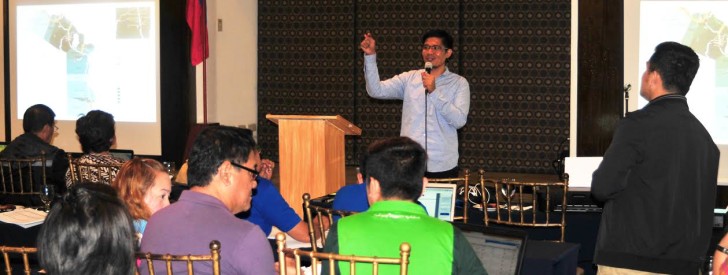 Joseph Pacon (Center) from the PRDP NPCO’s Geomapping and Governance Unit discusses how to plot socio-economic and geographic data into maps. (Photo by Lorenzo B. Villacorte, Jr., DA-PRDP PSO South Luzon M&E Unit)
Joseph Pacon (Center) from the PRDP NPCO’s Geomapping and Governance Unit discusses how to plot socio-economic and geographic data into maps. (Photo by Lorenzo B. Villacorte, Jr., DA-PRDP PSO South Luzon M&E Unit) South Luzon’s I-PLAN starts the year with workshops; promotes use of PRDP’s science-based tools
For the first month of the year, the PRDP South Luzon Project Support Office (PSO) started with a series of strategic planning workshops.
The PSO gathered on January 25–29 its Provincial Project Management and Implementation Units (PPMIUs) and Provincial Core Planning Teams (PCPTs) for a three-day Writeshop for the Finalization of the Provincial Commodity Investment Plans (PCIPs), and a two-day Scoping and Action Planning Workshop for the Preparation of Cluster Value Chain Analysis (VCA).
Rey Lara, the PSO’s I-PLAN Planning Specialist, emphasized the PRDP’s goal of mainstreaming its science-based tools and best practices to serve as models for all local government units (LGUs) to follow. He said that PRDP wants to ensure the operational use of the PCIPs for the development of the agricultural and fisheries sector at the local level.
Participants to the week-long workshops were tasked to update and improve their PCIPs based on the result of last year’s South Luzon PSO and National Project Coordination Office’s joint technical reviews. Needed improvements included the addition of commodity flow maps, trader maps, processor maps, infrastructure support-based maps, and road density analysis.
Geomapping, Vulnerability and Suitability Assessment (VSA), Expanded VSA (e-VSA), and geotagging are the science-based tools and innovations used by PRDP to facilitate easier and better strategic planning that involve agro-climatic, socio-economic, and geographic data. Thus, these tools are critical in the preparation of PCIPs. (Learn more about these tools.)
Aside from giving a lecture on geomapping, VSA, e-VSA, and geotagging, Joseph Pacon from PRDP’s Geomapping and Governance Unit (GGU) also guided the participants on the said tools through hands-on geomapping exercises.
Marian Cunanan, Planning Officer from the Province of Marinduque, shared that data in the form of maps or visuals are easier to interpret than pure words and numbers. A Planning Officer from Masbate, Roberto Leyco, was also glad that through the lecture, he and his fellow participants became more familiar with geomapping. He added that they can now easily apply geomapping for their PCIPs and VCA.
Pacon explained that GGU aims for transparency through geomapping and geotagging. He also mentioned that the many processes involved in planning such as identification of location, validation, implementation, construction, operation, and maintenance are participatory because they involve the different sectors in the community.
Getting both the public and the private sectors involved in the implementation of PCIPs is also one of the targets of PRDP according to Lara. He furthered that finalized PCIPs will be presented to national government agencies, and to interested and viable investors and markets. “We do not want our PCIPs to be locked in our cabinets,” Lara stressed.
On the same week, the representatives of the PPMIUs and PCPTs per province of South Luzon presented their action plans for the operationalization of their PCIPs. Everyone participated by giving constructive comments to the presenters.
Led by the PSO’s I-PLAN team, the workshop participants also discussed their specific roles and responsibilities for the data gathering, processing, and completion of cluster VCA reports. Lara asserted that cluster VCAs will help the South Luzon cluster identify how to strengthen the links in the commodity value chain that will later on result to the cluster’s enhanced productivity and competitiveness. Lara also mentioned that PRDP is not only process- and results-oriented, it is also participatory. He said, “we want to empower the actors (at the local level),” and help them develop commodities that can be identified as products of South Luzon, as “the identity of South Luzon.”
What is challenging here, according to Leyco, is the action planning and getting the full commitment of the LGUs to follow the PRDP’s set processes and market the PCIPs in the province. On the other hand, Cunanan is certain of the LGUs’ commitment stating that “PRDP is an opportunity for us. It gives us hope that many of our projects have chances of being implemented.” ### (Gumamela Celes Bejarin, DA-PRDP PSO South Luzon InfoACE Unit)
